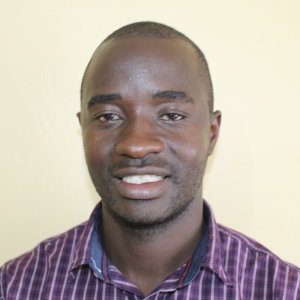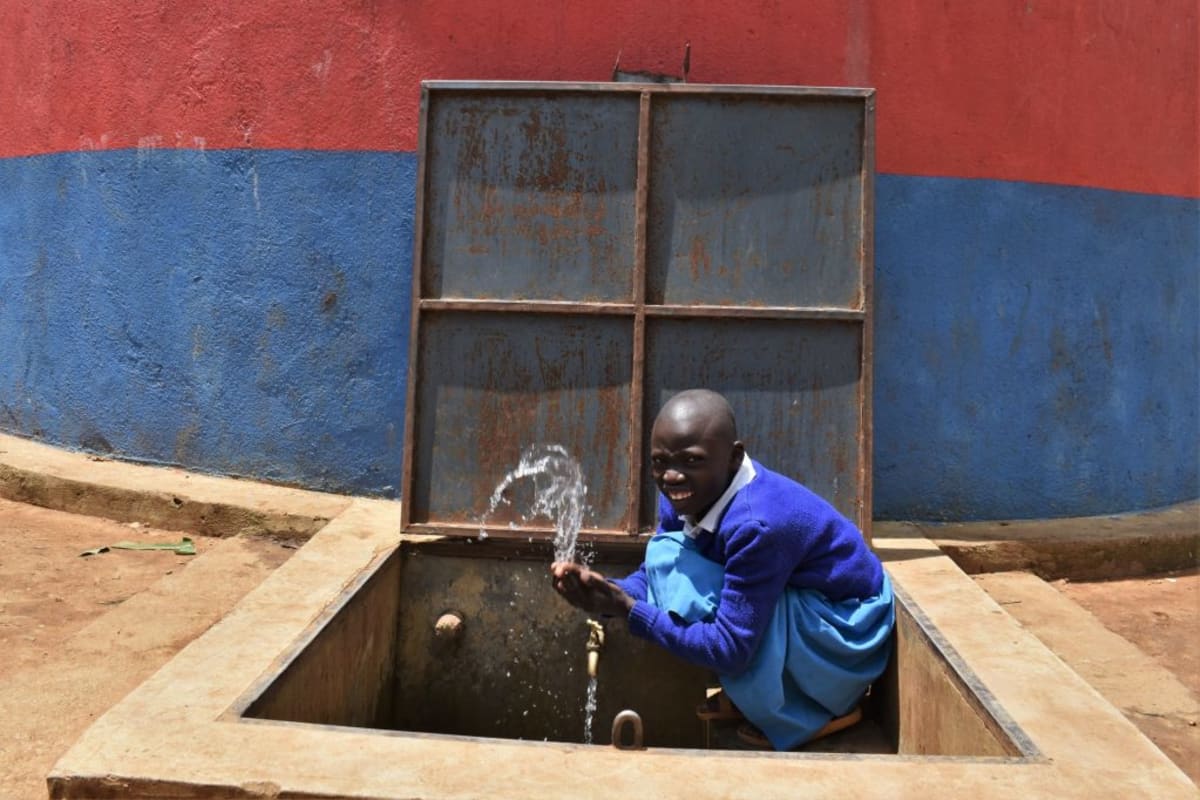December, 2020: Ivakale Primary School & Community Project Complete!
Ivakale Primary School and community in Kenya now have access to a new source of safe, clean water thanks to the completion of their two rain tanks, which have the combined ability to collect 100,000 liters of water! We installed new latrines and handwashing stations for students at the school, and we trained students, school staff, and community members on improved sanitation and hygiene practices. These components work together to unlock the opportunity for these people to live better, healthier lives.

Students give thumbs up in front of one of the two new rain tanks
"First of all, the assurance that we will be drinking safe water will give me more confidence to use the water and thus help me love my school the more. It speaks to a lot of love, care, and concern that the world around me has for children like me," said student Anne.
"Besides this, this water point provides us with a place to learn responsibility. Water is life, and every drop must be utilized most effectively and efficiently. The student health club training put a lot of premium on us to ensure that the tank is maintained and the tap is not damaged. Thus, my life will be elevated to a new, comfortable, and conducive learning environment to enable me to realize my goals for life."
Specifically, Anne continued, "The water point will enable me to realize the good of great academic performance and drive me into my dream career in life. Every morning when I wake up to attend school, I will no longer be bothered with the budget of carrying a load of water on my head to school. Instead, my focus will be on how to get to school in time for learning purposes. As a girl, I am now assured of adequate water to maintain hand hygiene and use even during menses. It is very shameful to lack such an essential commodity during one's menstrual period. This water point has come to rescue many girls from such a social dilemma," she said.

Students collect water from the second rain tank
School staff and parents were just as excited as the students about the new rain tank on campus.
"For a very long time, I've observed with a lot of sadness in my heart students carrying water from home or breaking class to fetch water outside the school compound. As a school guard, I could not assure any parent that they would be safe outside there. This kept me worried and disturbed because I am also a parent in this school," recalled Mr. Ernest Ambani.
"But, the two tanks have now solved this quagmire, and instead, a lot of joy and satisfaction have been added in my life as I perform my duty to this community. Besides, I will also drink safe water and eat food prepared from water whose source and quality status we can tell a story about."

Mr. Ambani took responsibility for safeguarding the project materials at school before work began.
"This water point will help control the movement of students outside the school. Thus, truancy and lateness will be curbed and put to check in the most effective way. No learner will hide under the disguise of going out to fetch water to engage in any unbecoming behavior, as was observed before."
"Another important thing that the project will help the school complete the syllabus in time. Ultimately, it will be able to project an improvement in academic performance. Going out to fetch water was not only a deterrent in early completion of academic work, but it also discouraged pupils in a big way. None of them ever enjoyed carrying water from home or fetching it from the water sources outside the school," Mr. Ambani said.

A student collects water from a rain tank
Rain Tank
Construction for the two 50,000-liter rain tanks was successful!
Even after schools closed, parents, staff, and students helped our artisans gather everything needed for construction. The school cooks and community members prepared meals for the artisans, and the school provided accommodations for the artisans during their work. Local women and men helped our artisans with their manual labor, too.

Students helped deliver the water needed for construction even after their school closed
The process officially began with our staff and the school administration looking around the school compound to determine the best locations for the two new rain tanks. These needed to be the best sites with enough land and a nearby building with good, clean roofing to catch the rainwater.

Marking the first rain tank's foundation site
Then, we cleared the sites by excavating the soil to make level ground for the tank foundations. We cast the foundations by laying big stones on the level ground and reinforcing them using steel wire, concrete, and waterproof cement. We affixed the drawing pipes and the drainage pipes as we laid the foundations.

Setting the tank's stone and wire foundation
Next, we formed the outer walls using a skeleton of rebar and wire mesh with sugar sacks temporarily tied to the outside as backing. We attached this skeleton to the foundations' edges so that the work team could start the Ferro-cementing process. They layer the walls with cement, alternating with the inner and outer side until six cement layers are in place. (We remove the sugar sacks once the interior receives its first two layers of cement.)

Interior tank wall and pillar plasterwork underway
Inside each tank, we cast one central support pillar to ensure the domes would not cave in once cemented. Meanwhile, we plastered the inner walls while roughcasting the outer walls. Outside of the tanks, the taps' access areas were dug, plastered, and a short staircase installed, along with a soak pit where spilled water can drain from the access area through the ground. This helps to keep the tap area dry and tidy.

Exterior plasterwork
Dome construction could begin after the tank walls had been given enough time to settle. Using similar techniques used on the walls, the dome started as rebar, wire mesh, and sugar sacks and was attached to the tank walls before receiving cement and plaster. A small manhole cover was built into each dome to allow access for future cleanings and water treatments.

Working on the dome
Lockable manhole covers were fitted over the tap areas, the gutters were affixed to the roof, and the tanks and overflow pipes were set in place at the edge of the domes for when the tanks reach capacity.
Once finished, we gave the rain tanks three to four weeks to undergo complete curing. Finally, the dome sugar sacks were removed, the tank was cleaned, and we waited as rain filled the tanks with fresh water. When there was a sufficient volume in each tank, we treated the water to ensure its safety before use.

Water begins to flow from a rain tank
We officially handed over the new project to the school community on the same day as training. Executive Director Catherine Chepkemoi led the handing over process. The school sponsor, Salvation Army Major Mable Mutoro, led the group in special dedication prayers. Apart from the school board of management team, other notable stakeholders who attended included the area assistant chief Mr. Joshua Livavo, the village administrator Mr. Jethro Anami, spiritual leaders from other local churches, community members, and of course, the school pupils. We asked representatives from each group to join the Salvation Army church leaders and lay their hands on the new WASH facilities to share a thanksgiving prayer to everyone who made the project possible and to give glory to God.

People joined in prayers of thanksgiving at the handing over celebration.
The school community appreciated the entire project, from latrines to the two rain tanks, to the handwashing stations. They were greatly overjoyed because the facilities were painted with special colors that recognized the input of various donors and stakeholders. The project has given the school a new facelift compared to no other in their vicinity.

Students give thumbs up while fetching water from one of the rain tanks.
VIP Latrines
This project funded the installation of six new ventilated improved pit (VIP) latrines at the school, three for girls, and three for boys.

Girls pose in front of the entrance to their new latrines.
These new latrines have cement floors designed to be easy to use and clean, locking doors for safety and privacy, and vents designed to keep air flowing up and out through the roof. With a rain tank right on school property, there should be enough water to keep them clean.

Boys pose in front of their new latrines.
Handwashing Stations
The two handwashing stations were set up during training and handed over to the student health club. These were placed outside of the girls’ and boys’ latrines to encourage handwashing after latrine use.

Student Metrine washes her hands.
Health club members will teach other students how to wash their hands at the stations properly, make sure the stations are filled with water, and ensure that there is always a cleaning agent such as soap or ash available.

Student Brian washes his hands.
New Knowledge
The school head, Mr. Dominic Lando, together with the school board of management chairperson, Mr. Jairus Anale, helped to convene the hygiene and sanitation training. They also helped to recruit participants, being careful to invite an equal representation of both genders.
The final group gathered included 53 people, among them pupils, school teachers and staff, the school board of management, students' parents, and local leaders. The attendance was beyond the initially proposed number, but the facilitators welcomed all to attend as long as participants adhered to physical distancing and mask-wearing whenever possible. Our team attributed the strong turnout to the high premium that the community put on the project upon its completion, in addition to their eagerness to learn more about hygiene practices amidst the COVID-19 pandemic.

Director Catherine Chepkemoi addresses parents, school staff, and other stakeholders at training
When the training day arrived, team leader Catherine Chepkemoi with facilitators Marry Afandi and Erick Wagaka deployed to the site. We held the training within the school compound with both outdoor and indoor settings. Outside, we engaged the parents and other adult stakeholders, while inside, we trained the pupils inside one of their classrooms for most sessions. We held the students' practical sessions, including rain tank maintenance and handwashing, outside to use the newly installed WASH facilities.

A student masked up and ready to learn at training.
We focused training on COVID-19 prevention, transmission, and symptoms while also covering several other topics. These included personal hygiene such as bathing, oral hygiene, the ten steps of handwashing; environmental hygiene; child rights, operation and maintenance of the rain tank, latrines, handwashing stations; and leadership and governance. During the latter among the students, they elected their peers to lead their newly formed student health club.

Students demonstrate the ten steps of handwashing during their practical session.
The club will be significantly involved in the water, sanitation, and hygiene project management at school. It will encourage good health and hygiene practices amongst their peers, teachers, and the larger community. We involved stretches, dances, and physical activities between each topic to keep the pupils’ energy up and their minds active. By the end of the training, each pupil understood their role in sustaining clean water and good health within their school community.

Trainer Mary tells students how to check and clean the gutters.
"This training was very valuable because it provided very helpful information on the operation and maintenance of the WASH facilities. I've learned that Ferro-cement rainwater catchment water tanks need special care to prolong their lifespan through it. Some of the key messages that will be of great importance to us as a school include gutter cleaning, tank cleaning, and water treatment of the tank water before it is used for drinking purposes. The knowledge about water treatment will also be applied at household levels," said pupil Metrine.

Metrine collects water from the rain tank
The session on the community's contributions to the project was by far the most memorable. This was because the Ivakale community accomplished the mobilization of the construction materials and the local laborers' work in a unique way. For instance, it was not easy to assemble all of the local materials needed for putting up the two rain tanks and the two triple-door VIP latrines. But the school community left no stone unturned in ensuring that they used every available resource at their disposal to realize the project's success.
Another interesting thing about this topic was how the gatekeepers of this community lent their hands to achieve the project's goal. Many older adults and the local leaders were not only present at the school each day of the implementation phase, but they actively participated in digging the latrine pits, doing the work, and providing moral support to the school administration as well as to the skilled artisans. This enabled the community to feel full ownership of the project.

Community members put in a lot of hard work to see the project to completion; here, they help prepare concrete during rain tank construction.
The session on hygiene promotion practices was another memorable one. As we conducted the training in the middle of the COVID-19 pandemic, everyone was scared about their life and that of their loved ones. As a school, various stakeholders at the training emphasized putting a premium on the health and wellbeing of both the learners and the general public that interacts with them daily. Consequently, the training participants were equally keen to know more about the novel coronavirus and equip themselves with knowledge on fighting COVID-19 at home and school.

Physical distancing at the rain tank
Our trainers emphasized the importance and effectiveness of physical distancing, wearing face masks, and practicing regular hand hygiene as some of the approved mechanisms to prevent and control the spread of COVID-19. At the end of the discussion on this topic, the group agreed that each person had a crucial part in keeping their community free from COVID-19.
"The training boosted my confidence that we can be safe from COVID-19 when we follow the correct prevention and control measures to curb this disease," said pupil Brian.
"We had lived in fear, but the emphasis on physical distancing, wearing of face masks in the right way, and doing correct handwashing will greatly help this community to work together in keeping ourselves safe. Thus, when we open school, I will be able to recruit my fellow learners to become worthy soldiers in the fight against COVID-19 and any other hygiene-related diseases."

Brian fetches water from the rain tank
"Before the training," Brian continued, "only a few people were practicing wearing face masks in public places. The majority of us, more so children and the youth, were mingling with each other without wearing the masks. Handwashing was also being practiced in a very poor manner, sometimes only when one wanted to eat. There existed the mentality that COVID-19 is still far off from village residents."
"The training is a wake-up call to step up handwashing, wearing of face masks at all times while in public places, and to practice effective two-meter physical distancing from each other. It also calls on the community members to avoid social gatherings that would predispose one to the disease by increasing the risk of its spread. There always exists a tendency of people greeting each other or even sharing food when they attend social functions such as funerals and weddings, thus avoiding such gatherings were deemed effective in disease prevention."

Brian leaves the tank with a jerrycan full of clean water.
When an issue arises concerning the water project, the students and teachers are equipped with the necessary skills to rectify the problem and ensure the water point works appropriately. However, if the issue is beyond their capabilities, they can contact our field officers' team to assist them. We will also continue to offer them unmatchable support as a part of our ongoing monitoring and maintenance program.
Thank you for making all of this possible!


 Rainwater Catchment
Rainwater Catchment
 Rehabilitation Project
Rehabilitation Project



















































